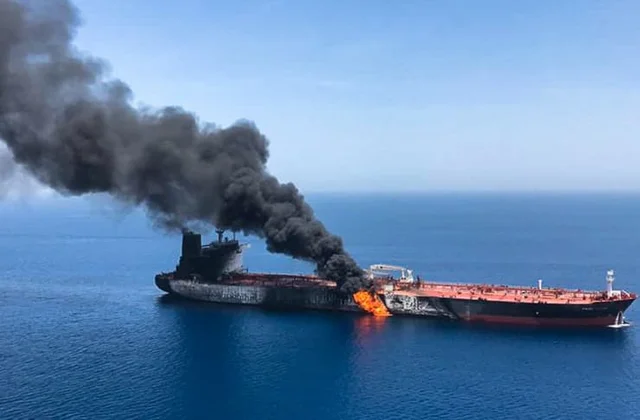

A picture obtained by AFP from Iranian News Agency ISNA on June 13, 2019 reportedly shows fire and smoke billowing from Norwegian owned Front Altair tanker said to have been attacked in the waters of the Gulf of Oman.
(snip)
WASHINGTON – Secretary of State Mike Pompeo on Thursday blamed Iran for attacks this morning on oil tankers in the Gulf of Oman near Iran and the Strait of Hormuz, a vital shipping route through which much of the world’s oil passes.
“Iran is lashing out because the regime wants our successful maximum pressure campaign lifted,” Pompeo said. “No economic sanctions entitle the Islamic Republic to attack innocent civilians, disrupt global oil markets and engage in nuclear blackmail.”
“The international community condemns Iran’s assault on the freedom of navigation and the targeting of innocent civilians,” Pompeo added.
The White House said President Donald Trump had been briefed and that the U.S. government would continue to assess the situation. Washington accused Tehran of being behind a similar attack on May 12 on four tankers in the same area, a vital shipping route through which much of the world’s oil passes.
No one has claimed Thursday’s attacks and no one has specifically blamed them on any party.
“U.S. Naval Forces in the region received two separate distress calls at 6:12a.m. local time and a second one at 7:00 a.m. U.S. Naval Forces Central Command received the calls from the M/V Front Altair and M/V Kokuka Courageous, who were operating in international waters of the Gulf of Oman. USS Bainbridge (DDG 96) was operating in the vicinity and provided immediate assistance to the M/V Kokuka Courageous. Twenty-one mariners from the M/V Kokuka Courageous, who abandoned ship, are currently aboard USS Bainbridge. A Navy P-8 is also providing support.”
The attacks in the Gulf of Oman renewed geopolitical concerns that have largely abated in recent weeks.
The Nimitz-class aircraft carrier USS Abraham Lincoln transits the Indian Ocean.
Chief Mass Communication Specialist Eric Powell | US Navy
The movement of additional U.S. forces to the Middle East is the Trump administration’s latest effort to pressure Tehran over its support for weapons proliferation and extremist groups in the Middle East.
Last month, Trump ordered new sanctions placed on Iranian metals, Tehran’s largest non-petroleum-related source of export revenue. The U.S. also took aim at Iranian oil by effectively ordering countries worldwide to stop buying Tehran’s oil or face sanctions of their own.
(snip)
Tehran announced it was relaxing some restrictions on its nuclear program but would not violate a 2015 accord with Russia, China, Britain, France, Germany and the United States. Iran had agreed to the 2015 limits on its disputed nuclear program in return for sanctions relief.
A year ago Trump withdrew the U.S. from the Joint Comprehensive Plan of Action, calling it a “horrible, one-sided” deal.
*see full story by CNBC